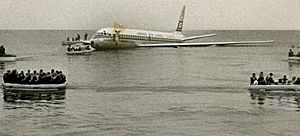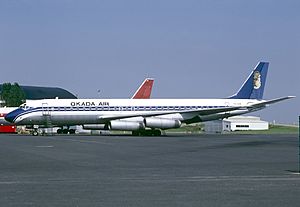Japan Air Lines Flight 2 facts for kids

Japan Airlines Flight 2 in the water short of the runway at San Francisco International Airport
|
|
| Accident | |
|---|---|
| Date | November 22, 1968, 1724:24 UTC (9:24 a.m. PST) |
| Summary | Accidental ditching on approach due to pilot error |
| Site | San Francisco Bay, San Mateo County, California, USA 37°35′25″N 122°18′19″W / 37.59028°N 122.30528°W |
| Aircraft | |
| Aircraft type | Douglas DC-8-62 |
| Operator | Japan Airlines |
| Registration | JA8032 |
| Flight origin | Tokyo International Airport |
| Destination | San Francisco International Airport |
| Occupants | 107 |
| Passengers | 96 |
| Crew | 11 |
| Fatalities | 0 |
| Injuries | 0 |
| Survivors | 107 (all) |
Imagine flying in a big jet, ready to land, when suddenly you splash down in the water instead of on the runway! That's what happened to Japan Air Lines Flight 2 on November 22, 1968. This flight was heading from Tokyo to San Francisco International Airport (SFO).
The plane, a new Douglas DC-8-62 named Shiga, was supposed to land safely. However, because of thick fog and some mistakes by the pilot, Captain Kohei Asoh, the plane landed in the shallow waters of San Francisco Bay. It was about two and a half miles (4 kilometers) short of the runway. Amazingly, all 96 passengers and 11 crew members were safe and unhurt!
Contents
The Flight's Journey
Flight 2 was scheduled to leave Tokyo at 5 p.m. on November 22. It was supposed to land in San Francisco at 10:15 a.m. But the flight was delayed a bit. This was because some instruments on the pilot's control panel were not working correctly.
Captain Kohei Asoh was in charge of the flight. He was joined by First Officer Joseph Hazen, flight engineer Richard Fahning, and navigator Ichiryo Suzuki. The flight went smoothly for the first eight hours.
Approaching San Francisco
As the plane got closer to San Francisco, air traffic controllers in Oakland started guiding it. The pilots were told that visibility at San Francisco Airport was very low due to heavy fog. They were advised to wait, but Captain Asoh decided to try an "automatic-coupled Instrument Landing System (ILS)" approach. This system helps planes land automatically in bad weather. It was something he hadn't done often in this type of plane.
The plane began to descend from its high cruising altitude. Air traffic control kept giving updates on the fog. The visibility on the runway kept getting worse.
Captain Asoh asked for a "long final approach." This meant a straighter path to the runway. It would give them more time to line up. The autopilot and flight director systems were set to guide the plane.
As they got closer, air traffic control gave more instructions. Captain Asoh set the autopilot for the ILS approach. He also slowed the plane down. He used one instrument, the radio direction indicator, more than another, the glide slope indicator, which was not working well. Also, Captain Asoh didn't fully trust his altimeter (an instrument that shows altitude). It had been replaced before the flight and seemed to give strange readings.
The Ditching
The cloud ceiling was very low, only about 300 feet (91 meters) above the water. It was hard to tell the difference between the foggy sky and the calm bay water. Because of this, the pilots didn't realize they were too low until it was almost too late.
Captain Asoh had set an alarm for a minimum altitude of 211 feet (64 meters). This alarm went off. As Captain Asoh looked for runway lights, the copilot, Captain Hazen, shouted: "We are breaking out of the overcast — I cannot see the runway light — we are too low — pull up, pull up!"
Captain Asoh said he saw the water after the plane came out of the fog. He quickly tried to pull the plane up and speed up the engines. But it was too late. The plane's landing gear hit the water first. It landed in the bay at about 9:24 a.m.
A passenger named Walter Dunbar remembered: "We came in alongside the mountains and went into thick fog. The next thing I knew, we were about one foot off the water. She hit, skipped twice, then nosed up."
The plane landed in shallow water, about 7 feet (2.1 meters) deep. This meant the front doors of the plane stayed above the water. The chief purser, Kazuo Hashimoto, said there was no panic. He tried to use the plane's announcement system, but it wasn't working. So, he shouted to the passengers: "Be quiet, the plane has reached the bottom of the sea. It will not sink. Do not worry, we are well-fixed for evacuation."
Everyone got off the plane using lifeboats. Police and Coast Guard boats towed the lifeboats to the nearby Coyote Point Yacht Harbor. Captain Asoh was the last person to leave the plane. He even went back to get passengers' belongings after everyone was safe.
The US National Transportation Safety Board (NTSB) said this was the first successful water landing of a jetliner. The high tide that day, about 7 feet (2.1 meters) deep, might have helped. It made the water deep enough to cushion the landing but shallow enough for the doors to stay above water.
Why Did It Happen?
"The probable cause of this accident was the improper application of the prescribed procedures to execute an automatic-coupled ILS approach. This deviation from the prescribed procedures was, in part, due to a lack of familiarization and infrequent operation of the installed flight director and autopilot system."
Captain Asoh was a very experienced pilot. He had flown for Japan Air Lines for 14 years and had about 10,000 hours of flight time. His first officer, Captain Joseph Hazen, also had a lot of experience.
The NTSB investigated the accident. They found that Captain Asoh did not follow the correct procedures for an automatic landing using the ILS system. He set the autopilot for ILS capture too late, when the plane was already too low. The instruments in the cockpit should have warned the crew much earlier.
Other pilots from Japan Air Lines also said they hadn't been properly trained on the flight director system. This led to changes in the training program for pilots. The NTSB also thought that the language difference between Captain Asoh (who was Japanese) and First Officer Hazen (who was American) might have played a small part. They felt there wasn't enough "understanding, coordination, and confidence" between them.
The "Asoh Defense"
When the NTSB asked Captain Asoh about the landing, he openly admitted it was his fault. This honest acceptance of blame was later called the "Asoh defense" by a writer named Jerry B. Harvey. It became an example in books about how people behave in groups.
What Happened Next?
The plane was not badly damaged. It was recovered from the water 55 hours after the incident. Large cranes were used to lift it out. After being cleaned with fresh water, the plane was taken to the airport on a large barge.
Once at the airport, the plane, Shiga, rolled off the barge on its own landing gear! The damage was very small. Only one wheel on the right landing gear was broken. Repairs were estimated to take less than six months.
United Airlines offered to fix and refurbish the plane for about $4 million. Japan Air Lines agreed. The plane was repaired and returned to JAL in March 1969. It even had a successful test flight. The plane was renamed Hidaka and continued to fly for JAL until 1983.
Captain Asoh was not allowed to fly passenger planes for a while. He was demoted to First Officer and received more training. He continued to fly for JAL until he retired. Hazen also returned to flying a few months later.
Today, Japan Airlines still has a flight named Flight 2 (JAL002) from Haneda to San Francisco. It now uses a much larger Boeing 777-300ER aircraft.
The Plane's Later Life
The plane, JA8032, was sold to other airlines after leaving Japan Air Lines. It flew for Air ABC, then for Okada Air, and finally as a cargo plane for Airborne Express. It was eventually taken out of service and scrapped in December 2001.
Images for kids




